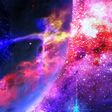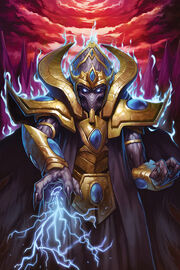
|
You may be looking for:
|

Khalai operating in tandem through the Khala
The Khala ("Path of Ascension") was the main religion of the Khalai protoss. It was based on a psionic philosophy that maintained a communal psionic link between all adherents.[1] Followers were further subdivided into at least five levels of adepts.[2]
The Nerazim and Tal'darim have never used the Khala;[3][4] the former group viewed it as the robbing of individuality,[5] and the latter has never submitted to it.[6]
History
The Original Link
In their plot to create the perfect creatures to end the Infinite Cycle, Amon and the xel'naga who followed him broke their rule of noninterference and came to Aiur. Seeing beings who had the potential for purity of form, they began to manipulate the natural psionic link they had developed to accelerate their potential. This would have the added bonus of allowing Amon and his xel'naga to assert direct control of the protoss if needed.[7][8]
After a millennium of subtle manipulation the xel'naga revealed themselves to the protoss and interacted with the nascent species directly. However, the xel'naga discovered the maturation of the tribal social structure and the rise of individualism was adversely affecting the psionic link. Eventually the psionic link was broken. The protoss could still telepathically communicate and read each others thoughts, but the empathic bond was lost.
The end of the empathic bond caused Amon's xel'naga to regard the protoss experiment as a failure and they departed Aiur, resulting in the Aeon of Strife.[1]
The Aeon of Strife

Khas brings the Khala
Near the end of the Strife a protoss named Savassan, later known as Khas ("he who brings order"), found the khaydarin crystals left behind by the xel'naga on Aiur. Savassan touched the crystals and rediscovered the psionic link. With knowledge gained from researching other xel'naga relics, Savassan learned how to rekindle the empathic bond. He recorded these findings, the founding precepts of the Khala, so that the protoss might once more become a unified communal society.

The protoss access the Khala
Many protoss both revered and hated the xel'naga and the hatred fueled the Strife. Khas believed the Khala would allow the protoss to embrace the positive emotions all protoss shared to negate the destructive self-hatred. As Khas saw it the protoss did not need the xel'naga, only the once-lost emotional link. Khas thus ended the Aeon of Strife and brought on the protoss' Second Age.[9]
The Khala formed the foundation of future protoss psionic techniques, especially powerful abilities such as the psionic storm.[1]
Unbeknownst to Amon or the protoss, the creation of the Khala disturbed the xel'naga loyal to the tenants of the Infinite Cycle from their slumber, which lead to them discovering Amon's plot.[6]
The Modern Khala
Based on the Khala, protoss society restructured itself to consist of three castes; the Judicator Caste (led by the Conclave), the Khalai Caste and the Templar. When the protoss became an active interstellar civilization once more after the Strife, the Khala led them to adopt the Dae'Uhl ("Great Stewardship") over less advanced species they discovered.[1]
Protoss who followed the Khala were often referred to as "Khalai" (used in a different sense from members of the Khalai Caste).[10]
Being subsumed in the Khala meant a certain loss of self in addition to the gain of the "other". There was a risk the loss could be drastic.[3][9] As a result some protoss rejected the Khala and severed their long head nerve cords to cut the empathic link. These outcasts formed into the Rogue Tribes and were later known as the Nerazim after their banishment from Aiur.[1]
Khala's End
During the reclamation of Aiur, Amon returned to the material universe. As he had no host body, he asserted his consciousness into the Khala itself. This allowed him to maintain himself in the material universe while controlling all protoss bound to the Khala.[7]
Dark Prelate Zeratul cut the nerve cord of the Daelaam Hierarch Artanis, but at the cost of his own life.[11] Artanis rallied what unconnected protoss he could,[12] and escaped Aiur.[13] However, those trained to master every intricacy of the Khala had the ability to resist Amon's posession[6], but only for so long. From there Amon used the corrupted protoss of the Golden Armada to purify worlds in his crusade to eliminate all life.
Phase-smith Karax, with the artifact known as the Keystone, discovered a way to pull Amon out of the Khala temporarily. If done so while the protoss around him severed their nerve cords, he would have no host to occupy after the Keystone failed and be thrust back into the Void.[14] Allying with the Nerazim who severed their connection to the Khala, the Tal'darim, who had never fostered their connection, and the Purifiers, machines made by the protoss, Artanis destroyed Amon's host body he formed on Aiur,[15] and used the Keystone to pull Amon from the Khala.
The remaining protoss under Amon's control severed their nerve cords, thus cutting the psychic link shared between all Khalai protoss and ending the Khala. Artanis then set out to create a new protoss society not bound by the Khala, but by the unity of their race.[16]
Uses

Khalai could access and control psionic energies through the Khala
It was very hard for Khalai to hide from one another due to the empathic link. Hiding was possible for all protoss during the Aeon of Strife when the link was suppressed. Non-adherents, like the Nerazim could still conceal themselves from other protoss.
The depth of the link varied according to personal choice. Generally it was difficult to be fully immersed in a state of unity all the time. Members of the Templar and Judicator Castes immersed themselves deeply several times per day, along with many Khalai, "nourishing" themselves through the rich contact and emerging refreshed and invigorated.[3]
The discipline of the Khala was required to control abilities such as the psionic storm.[1]
The Khala granted a protoss an enormous amount of psionic energy.[17]
Protoss cut off from the Khala are quickly embraced by the Void.[3][18] The drug Sundrop is capable of doing this, at the cost of mental imbalance.[3]
The fortitude of the Khala protected protoss from assimilation by the zerg.[19]
Memory Preservation
Khalai "entered" the Khala upon death but did not remain as complete or coherent entities.[3] Their last thoughts were automatically gained by protoss in close proximity to the deceased.[19] Rather, the Khala contained "resonances" of deceased Khalai, that remain long after the respective protoss's death.[20] As a result Khalai could sense memories and strands of experience of dead Khalai through the Khala, sometimes with the aid of the templar archives. However, only preservers had full access to this knowledge.[21] As more spirits entered the Khala, the stronger it became.[22]
The memories of other protoss could be accessed using these methods, but the memories of the Tal'darim of Aiur, who had been cut off from the Khala, could not be.[3]
Communication within the Khala
Protoss can communicate using a mental link (which transmits emotions) or simply through "speaking" (another form of mental link).[3] The nature of the Khala meant that Khalai did not have to speak vocally (whereas Nerazim must voice their words, allowing all around them to hear them).[23]
Protoss could create a special kind of mind-meld deep within the Khala, where no one can lie. Protoss performing this kind of mind-meld held up their hands and faced their palms to each other; both palms softly glowing. This kind of communication was also possible between Adun and Raszagal, the latter not following the Khala.[3]
Combining with the Void
Utilizing the Void and Khala simultaneously granted protoss incredible power, but could result in the protoss burning out like a star. Protoss who could utilize both sets of power simultaneously were exceedingly rare. Known practitioners were Adun[3] and Tassadar.[24]
Notes
In Blizzard's mind, the Khala was one of the four cornerstones of the protoss as a whole. From a literary standpoint, it has allowed them to explore themes of collectivism vs. individuality.[25]
References
|
